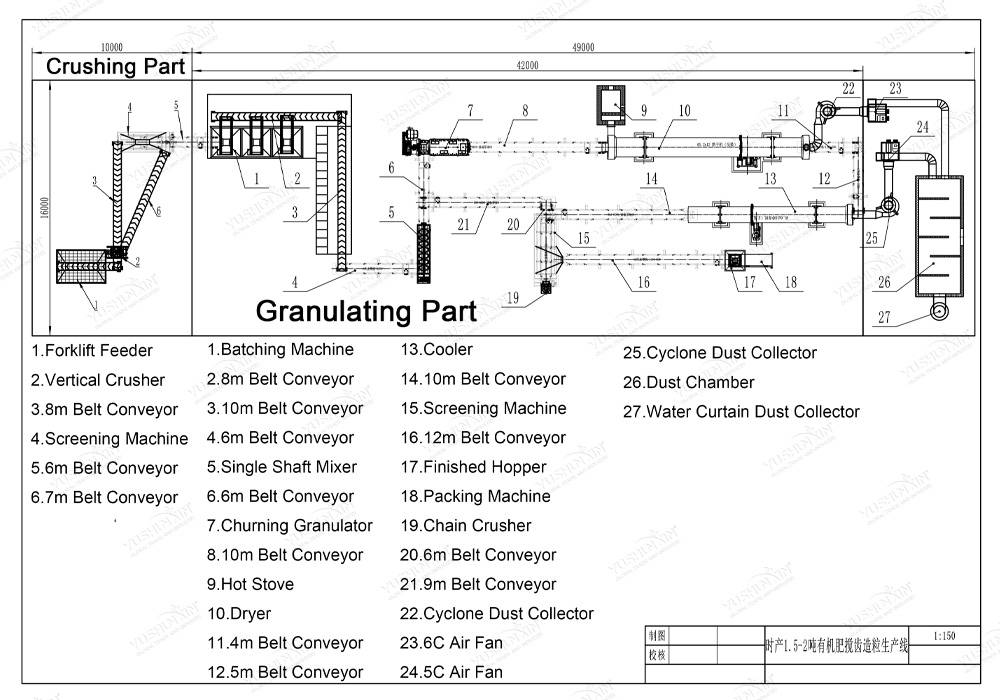







Phosphatgestein in eine verwendbare Düngerform umwandeln, Säure ist erforderlich, um “Sprudel” der Felsen, die lösliche Phosphorverbindungen freigibt. Häufige verwendete Säuren umfassen:
Zu erstellen NPK -Düngemittel, Andere Stickstoff- und Kaliumquellen können mit dem Phosphatmaterial gemischt werden. Einige Beispiele sind:
Die Kosten für jede Produktionslinie variieren je nach Produktionskapazität, Grad der Automatisierung, und spezifische Bedürfnisse. Füllen Sie das folgende Formular aus und wir geben Ihnen ein genaues Angebot zur Verfügung!
Wenn Sie sich für unsere Dünger -Herstellung von Geräten interessieren, Bitte reichen Sie Ihre Anforderungen und Kontakte ein und dann werden wir Sie in zwei Tagen kontaktieren. Wir versprechen, dass alle Ihre Informationen niemandem vorgestellt werden.
- Die Firma wurde in gegründet in 2005 und konzentrierte sich auf die Forschung und Entwicklung und Herstellung von organischen Düngemittelgeräten für 20 Jahre. Es hat eine 40.000 m große großflächige Produktionsbasis für Bio-Düngerausrüstung gebaut, mit fortgeschrittener Granulation, Trocknungs- und Screening -Technologien zur Verbesserung der Produktionseffizienz und der Produktqualität.
- Ein selbst betriebenes Import und Exportunternehmen mit mehr als 80 Professionelle Ingenieure weltweit, mehr als 100 Länder und Regionen auf der ganzen Welt, 5,000+ Kundendienstfälle, 10 Verarbeitungszentren, 3 Laserschneidmaschinen, und mehr als 60 Ausrüstung verschiedener Arten.
- Aufrechterhaltung der langfristigen und umfassenden Zusammenarbeit mit vielen wissenschaftlichen Forschungsinstituten und Universitäten, with a professional R&D team, Es kann die Ausrüstungsleistung entsprechend der Marktnachfrage kontinuierlich optimieren.
- Hochfeste Verschleißmaterialien, Kohlenstoffstahl Q235/Legierung werden ausgewählt, um sicherzustellen, dass die Geräte langlebig sind und die Wartungskosten senken.
- Einführung intelligenter Kontrollsysteme zur Verbesserung des Produktionsgrades und zur Verringerung der manuellen Abhängigkeit.
- ISO, Ce, SGS International Certification
- Mit groß angelegter Produktionskapazität, Es kann unterschiedliche Anforderungen an die Produktionskapazität erfüllen (klein, mittlere und große Produktionslinien).
- Eine breite Palette von Ausrüstungsmodellen, Geeignet für die Herstellung verschiedener Arten von Düngemitteln wie organischer Dünger, Verbunddünger, Biologischer Dünger, Wasserlöslicher Dünger, Flüssigkeitsdünger, usw.
- Personalisiertes Design kann nach Kundenbedürfnissen bereitgestellt werden, einschließlich Produktionskapazität, Standortlayout, Umweltschutzstandards, usw.
- Bieten Sie eine vollständige Reihe von Produktionsleitungslösungen an, einschließlich Auswahl der Ausrüstung, Installation und Inbetriebnahme, Technisches Training, usw.

- Direkte Fabrikversorgung, Reduzierung des Links im Mittelsmann, und der Preis ist wettbewerbsfähiger.
- Die Ausrüstung hat eine hohe Energieeffizienz, reduziert den Energieverbrauch, und hilft Kunden, langfristige Betriebskosten zu senken.
- Direkte Fabrikversorgung, Reduzierung des Links im Mittelsmann, und der Preis ist wettbewerbsfähiger.
- Die Ausrüstung hat eine hohe Energieeffizienz, reduziert den Energieverbrauch, und hilft Kunden, langfristige Betriebskosten zu senken.
Effiziente Lösung zur Kompostwende an einen philippinischen Kunden geliefert
Steigerung der Pelletierungseffizienz für die GoodEarth Group, Südafrika
Ecuadorianische Kunden loben die Abwasserentwässerungsmaschine stark
Das hohe Lob des Vietnam -Kunden für die Produktionslinie der Kaliumdünger
Die mexikanische Düngerlinie wurde erfolgreich installiert
Unsere Düngerproduktionsausrüstung wurde ohne Schaden erfolgreich nach Australien geliefert.